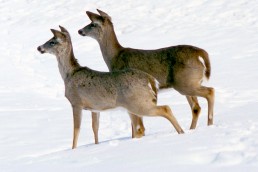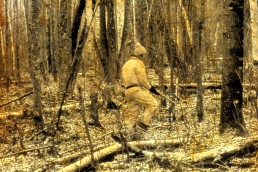Avoiding Being Identified by Ears of Whitetails
SHARE THIS POST
Today, it’s fashionable for deer hunters to use products claimed to mask or eliminate human odors and others so they’re undetectable and invisible to whitetails. Many do concern themselves with being heard by deer. But actually more near-encounters with whitetails, most of which occur without hunters realizing it, are spoiled by the sounds hunters make rather than their odors or if they have been sighted.
Whitetails can only recognize upwind hunters via smell, at best only one-quarter of an area surrounding them. It is often difficult for them to see enough of the body of a human hunter in wooded areas to positively identify him—often hidden, even within 50 yards—and, especially, the motionless stand-hunters. The only sense that gives whitetails constant and complete protection, awake or slumbering, and throughout a surrounding 360-degree circle with a radius of 200 yards or more, is their radar-like hearing (except in moderate-to-heavy precipitation). Approaching locations where whitetails are currently located, like feeding areas, for example, from downwind or crosswind makes it impossible for those deer to smell a hunter.
But almost all sounds made by those afield are dead giveaways.
Based on whitetail reactions, these sounds hunters make are considered dangerous or potentially dangerous, and are numerous: coughs, sneezes, sniffles, throat-clearing, spitting, nose-blowing, voices, metallic jingling of loose bullets, coins or keys in pockets, a rattling portable stand toted or lifted into a tree, attaching a portable stand, loading a rifle, clicks made moving a gun safety to off position or pulling back the hammer on a carbine, a squeaking sling swivel, bumping a gun barrel, batteries rattling in a flashlight, a needle rattling in a compass, fabric rubbing against rough tree bark, stumbles, jumps, dragging boot heels on gravel or frozen ground or through dead leaves, grasses, shrubs, etc., walking or wading through high water or frozen snow, ice breaking, dead branches stepped on or pushed through, plastic wrappers removed, a can or bottle being opened, carving, chopping, sawing or hammering on wood, zipping up a zipper or unsnapping or snapping a snap, running motor vehicles and the opening and closing of its doors and especially heavy footsteps or ones frequently interrupted by short periods of silence.
Of all the creatures known by experienced whitetails, only human hunters make these sounds above. (A backpacked, homemade hunting stool with its oak framework that makes no discernable sounds while toted or placed on the ground, is what I use and is recommended.)
Whitetails react with alarm, moving silently but quickly away or bounding noisily away upon hearing approaching footsteps that are frequently interrupted by short periods of silence, characteristic of a stalk. As grey wolves have often demonstrated, soft approaching footsteps not interrupted by periods of silence and not moving directly toward a mature deer do not greatly alarm whitetails. Upon hearing non-stop footsteps approaching and recognizing that it is a non-hunting presence nearby, most whitetails simply move out of the path of whatever is approaching, halt in nearby cover to watch it pass, and then resume whatever they were doing.
Are you enjoying this post?
You can be among the first to get the latest info on where to go, what to use and how to use it!
However, when whatever is approaching cannot be positively identified as something dangerous, mature whitetails and young accompanying deer that rely on older deer for leadership and direction, will not immediately abandon an area. They will be curious and be extra alert for a while and may even temporarily move out of sight of the hunter’s path or destination. But if the hunter can succeed in reaching a nearby stand site without being seen, smelled, or heard making sounds recognized as those of a hunting human, and, then sit still and completely silent without discernable movements, within 30 minutes those deer may likely be seen feeding in the adjacent feeding area and moving slowly and in sight of that hunter.
The ‘softer’ approach
To make softer footsteps, bend your knees and lift your feet clear of the ground and whatever is lying near your stand site. Then, approach the trail previously cleared of dead branches with each step. Though simple, this is awkward. To keep from dragging your feet while within 100 yards of your stand site, be aware of how you are stepping the entire way.
Mark your trail with fluorescent tacks, not red ribbons or blazes on tree trunks, as this will help you and make it unnecessary to halt frequently to find your way to the stand in darkness. I place a triangle of fluorescent tacks low on a tree trunk to warn myself when I’m near my treestand and that it’s time to turn off my flashlight. If it’s too dark at that point to proceed without a flashlight, I’ll generally halt for the first time within 100 yards of my stand site and sit quietly on a stool until it’s light enough to see my way without one.
If all of the above seems strange or unnecessary to you, this is likely the reason you seldom see older bucks, much less succeed at hunting one.
This, my friend, is buck hunting.
The only sense that provides whitetails with constant protection from danger in every direction is their radar-like hearing.
MWO
SHARE THIS POST
Did you enjoy this post?
You can be among the first to get the latest info on where to go, what to use and how to use it!
Dr. Ken Nordberg
Based on his 55 years of field research, Dr. Ken Nordberg has written more than 800 magazine articles, 12 books on whitetails—including the famous Whitetail Hunter’s Almanac series—five books on black bear hunting and produced Buck and Bear Hunting School videos. You may peruse his encyclopedic website with whitetail hunting tips: drnordbergondeerhunting.com, his blog: drnordbergondeerhunting.wordpress.com, or social media pages.



